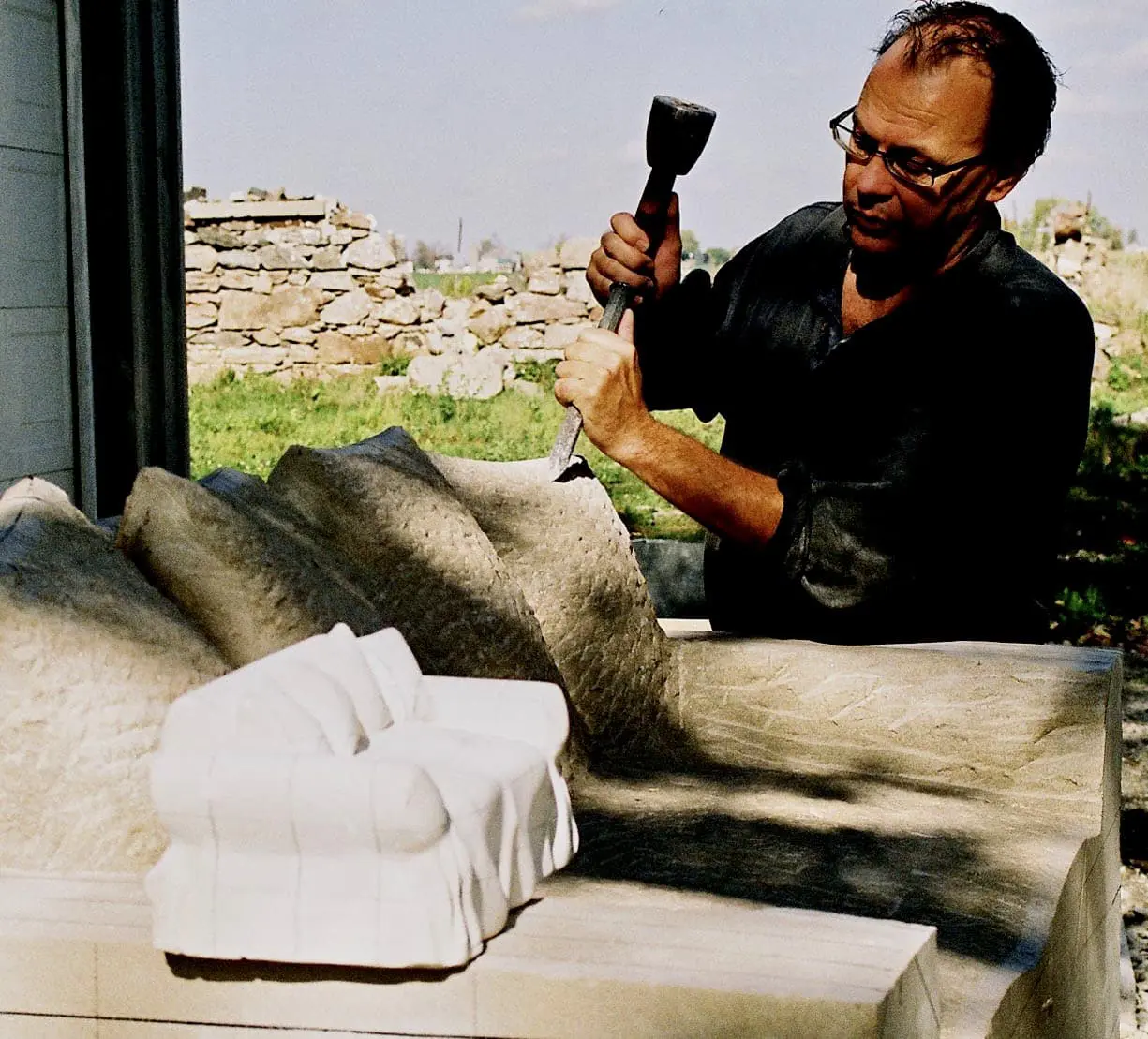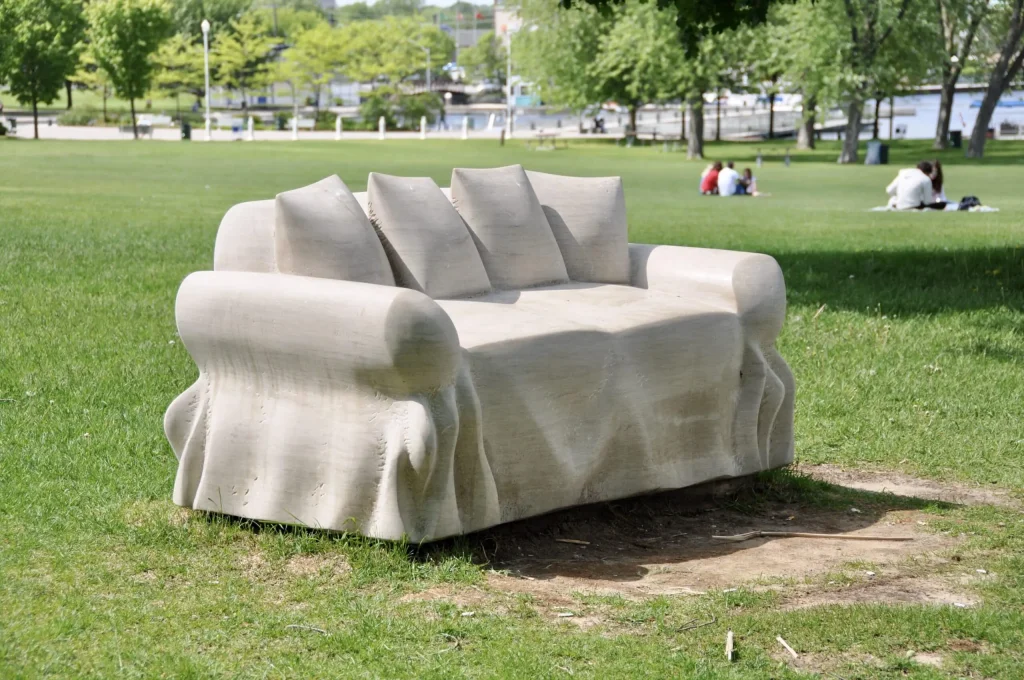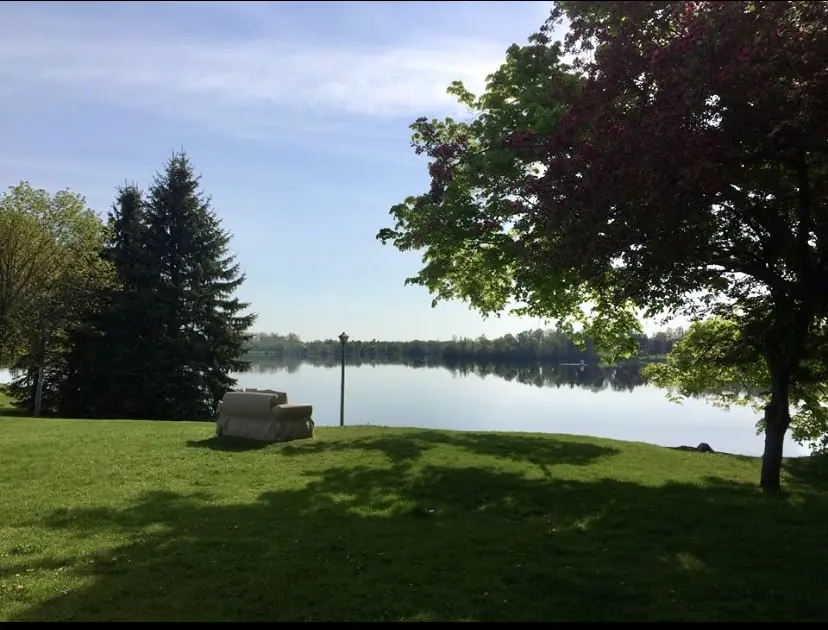Artists in Conversation: Ernest Daetwyler
August 5, 2020
Ernest Daetwyler in conversation with Fynn Leitch
Remote Interview: August 5, 2020
Fynn Leitch (FL): Thank you for agreeing to virtually chat with me about your work! Loveseat (2006) was installed behind the AGP facing Little Lake. From inside the gallery we watch the ways people interact with it. We have seen them approach your sculpture with curiosity, joy, trepidation. Some express delight in their initial misinterpretation of it as a discarded piece of furniture; some use it as a resting place; for some, it’s a place for a quick selfie. It presents today as poignantly as ever, perhaps with some new resonance to our current context.
I know that people are interested in how you made Loveseat, can you talk about your method and process of making this work?

Ernest Daetwyler (ED): About fourteen years ago, the Art Gallery of Peterborough launched a Call for Artists to propose public art projects that provide seating possibilities on the shores of Little Lake. Visiting and reflecting on the site, an idea took hold to create a comfortable sofa with cushions—a quite realistic love seat. Following a series of sketches and the decision to carve a loveseat in one large block of Indiana limestone, I created a small model in clay and cast it in plaster to serve as a reference for the sculpture. I carved the porous, “soft” limestone, selected for its ability withstand the seasons and harsh climate, over the course of several months at my studio in the countryside of South Western Ontario, near Kitchener-Waterloo.

FL: Can you speak to your original intentions for the work?
ED: After visiting the site, I thought about how to encourage visitors to chill and relax, take in the beautiful natural environment, and treasure the moment. I have always been intrigued by domestic furniture discarded or “placed” on the side of the road in all kinds conditions. By placing a loveseat in the open, the natural public park environment on Little Lake becomes a living room. A place to enjoy and take care of in the same way as a personal, private space.
FL: Do you see any new resonances with our current context?
ED: I think that our current pandemic highlights the importance of caring about each other as a form of love. COVID-19 has forced many people to spend time in their domestic quarters for an extended period, often isolated. Parents kept their children at home with new on-line learning school requirements while adapting to numerous other changes. Many may have gotten sick or lost a family member in a long-term care facility where COVID-19 cases took a severe toll.
Just before the pandemic, climate change dominated the news and found worldwide momentum with kids, students, and young people stepping forward in peaceful collective actions through school strikes including Fridays For Future. I think that multiple generations can relate to the conceptual approach and message of the “loveseat” not only because the sculpture addresses environmental concerns but also the notion of taking care, having anticipation and empathy, and engaging in various forms of love. We can turn to Greek philosophy for definitions of different kinds of love: Eros (sexual passion), Philia (deep friendship), Ludus, (playful love), Agape (love for everyone), Pragma (longstanding love), and Philautia (love of the self).The pandemic, which has forced human activities worldwide into a pause, has afforded us the time and space to think. Many of us have come to learn that love is really important in our lives in the sense of “agape”, love for everyone, and the community or the “polis”.
It also became rather evident that the consequences of the pandemic differ in terms of class and race, a fact that has illuminated an ever increasing and highly problematic divide in society. After a long history and recently documented police violence events, including the deaths of George Floyd and Breonna Taylor among countless others, massive Black Lives Matter protests erupted in cities all over the world with protesters asking for justice. The march I participated in Kitchener on June 3 showed unprecedented attendance with thousands and thousands of peaceful marchers in solidarity with BLM, chanting “No justice, no peace.” Social justice, in essence, is love and respect for everyone; “us” instead of “I.” Existential concerns, the news and social media can take a heavy toll on the well–being of people, particularly during a pandemic and self-isolation. I observed friends posting notices of selfcare needed—maybe an expression of “Philautia,” self–love—by taking a break from social media and the depressing charts of the developing pandemic. Spending time outside, if possible and ideally in a natural setting, has helped many overcome challenges during COVID-19. To close the circle, a sculptural work called “loveseat” in a natural setting does address the topic of love in all its forms, including on a lighter note “Ludus,” or playful love, and even “Eros”, or romantic love, by young couples who may not necessarily have been compliant with social distancing.

FL: Haha, yes, quite possibly! You have completed several commissions for public art. Can you speak to your approach to these types of projects?
ED: I approach any art project with new eyes—childlike and playful—trying to make sense of a new site, a place, a community, and the people living and working within the built and the natural environment.
Site visits with extensive research follows, which includes the practice of keeping an open mind where anything in any medium is possible. This is likely the reason why all my art projects vary so much in idea, concept, material, and medium. Every art project is completely different. One could say that the various multi-disciplinary projects realized in the past often involve curiosity, community participation, and an element of social or environmental activism, which offers surprise, awareness and inspires reflection and interaction.
FL: What are you working on now?
ED: Beside working on various art projects, my activities include grant applications, participating in Calls for Artists, public art competitions, and future possibilities.
Recently the City of Kitchener accepted a community public art project by donation and commissioned its placement in downtown Kitchener. The project , a sculptural work of a backpack in bronze and sandstone will be completed this Summer/Fall. The Kitchener City Council approved the motion to include the artwork in its public art collection and supports its installation in the Vogelsang Green Park. This art and community project has was been initiated by Suzi Gursoy, an advocate for the homeless community with lived experience, and member of The KW Homeless Memorial committee, which represents the local-nonprofit organizations involved in homelessness on the frontlines. The sculpture will raise awareness of homelessness and related issues, creating a place in memory of the many homeless people who have lost their lives in the region. has won an art project award by the Region of Waterloo Arts Fund, is supported by Ray of Hope, the House of Friendship, oneROOF, Lutherwood, MCC, YW, the Working Centre and has also found corporate and private donations through a GoFundMe page.
Also, a twenty-seven foot long sculptural work made in driftwood, which was on display at the McMaster Museum of Art for two years as an on-going temporary public art project, has just been placed in the Cambridge Sculpture Garden in downtown Cambridge.

FL: Has COVID-19 changed your approach to site-specific and collaborative work and if so how?
ED: I hope that the pandemic and this worldwide pause has reminded us of how vulnerable our environment and our society has become, how increasingly divided we are, and how important and crucial it is to restore the natural environment for future generations. If we can stop all activities across the globe for a pandemic, then it should be possible to restore the natural environment, and improve the quality of life for all people with a similar effort. These challenges are deeply connected. The pandemic has further cemented my belief that we are all in this together. Every decision and activity we engage in must be a conscious one that is meant to improve our lives and others in meaningful ways with a global perspective. Contemporary art projects, particularly in collaboration with a community, not necessarily have to but can be an instigating force for positive change and transformation.
Posted in Artist Interviews, Permanent Collection
